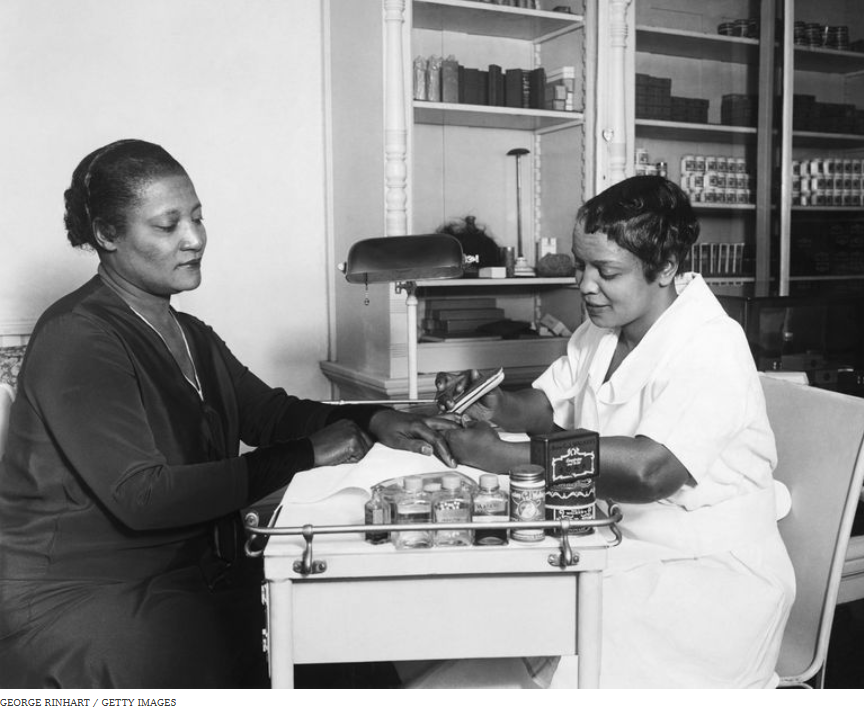Who Was Madam C.J. Walker’s Daughter A’Lelia And What Happened To Her?

She played a huge role in her mother’s success
If you’ve seen Netflix’s Self Made: Inspired by the Life of Madam C.J. Walker, then you know all about Sarah Breedlove (a.k.a. Madam C.J Walker), one of America’s first self-made female millionaires. The film follows Madam C.J., played by Octavia Spencer, on her journey to developing a black haircare empire. But she didn’t do it alone.
Her daughter, A’Lelia Walker, played by Tiffany Haddish, also had a significant role in the success of her mother’s company and eventually took over the business. Unfortunately, A’Lelia passed away in 1931 in the same way her mother did—from hypertension, according to a blog run by Madam C.J. Walker’s great-great granddaughter, A’Lelia Bundles.
But before she died, A’Lelia Walker accomplished a lot, not just for her mother’s company but for the black community at the time. Here’s everything we know about Madame C.J. Walker’s daughter, A’Lelia Walker.
A’Lelia was born Lelia McWilliams.
A’Lelia Walker was born as Lelia, according to Bundles. At 2-years-old, her father, Moses McWilliams died and Madam C.J.raised her as a single mother. The two moved to St. Louis to live with three of Madam C.J.’s brothers. Eventually, the mogul remarried to a man named Charles Walker (hence the name Madam C.J. Walker). A’Lelia took the Walker name to identify more closely with her mother’s business, according to Bundles’ blog. Here’s a photo of the real A’lelia Walker getting her nails done at one of Madam C.J.’s salons:

She moved to New York to expand the business.
In 1913, Madam C.J. purchased two townhouses on 136th Street in Harlem, according to the National Trust for Historic Preservation. She and A’Lelia hired an architect to combine the properties into one unit. Once complete, the first floor was used as the Walker Hair Parlor, the basement was the Lelia College of Beauty Culture, where new hires were trained, and the top three floors were used by A’Lelia to live and entertain.
A’Lelia was married three times.
Although
the Netflix docuseries hints that A’Lelia might have been interested in
women, she never admitted to it. In fact, A’Lelia was married three
times—all of her partners men, according to Bundles. You meet A’Lelia’s first husband in Self-Made—John
Robinson, the hotel worker who dreamed of opening a juke joint. Well,
you saw how that turned out. In 1919, A’Lelia reportedly married Dr.
Wiley Wilson after her mom died. And her third husband was another
doctor and World War I captain, James Kennedy.
Madam C.J. Walker’s Irvington, NY mansion was named after A’Lelia.
When Madam C.J moved to New York to be closer to her daughter she purchased a mansion in Irvington, New York for $250,000 (which was $$ back then!), according to the NY Post. The home was 20,000 square-feet, had a swimming pool, marble floor, and was in the same neighborhood as the Rockefeller family, which was shown in Self Made.
The mansion came to be called the Villa Lewaro, after Leila Walker Robinson (remember Robinson, her first husband?), according to NPR. Take the first two letters of her first, middle, and last name: Le-Wa-Ro.
She was played a major role in the Harlem Renaissance for the black and queer community.
Although the film paints A’Lelia as having her head in the clouds, she was a serious businesswoman. Before taking over the company when her mother died, A’Lelia ran the east coast operations of the business, according to Bundles’ blog. And when A’lelia moved to Harlem, she made a name for herself fundraising for charities and founding the Harlem Debutantes Club.
She
was also known for her lavish parties at both her home in Irvington and
at her Manhattan salon, known as The Dark Tower. “They provided a safe,
welcoming environment for queer people at a time when there were few
other social options available. While she herself was not known to be
lesbian or bisexual, Walker’s parties were places where anyone could
express their sexuality however they pleased,” NPR reported.
Many of Harlem Renaissance’s finest came to A’Lelia’s parties, including Langtson Hughes, Countee Cullen, and Carl Van Vechten. Hughes called her “the joy goddess of Harlem’s 1920s,” according to NPR.
Article via WomenHealthMag

